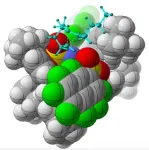(Press-News.org) Texas A&M AgriLife Research received more than $5.2 million in grant funding from the U.S. Department of Agriculture’s National Institute of Food and Agriculture for a project to address multiple aspects of the southern U.S. onion harvest system.
Subas Malla, Ph.D., Texas A&M AgriLife Research associate professor at the Texas A&M AgriLife Research and Extension Center in Uvalde, will serve as director for a short-day onion project. (Texas A&M AgriLife photo by Paul Schattenberg)
The director for the “Ensuring Future Economic Viability of U.S. Short-Day Onion Production Through Mechanical Harvesting” project will be Subas Malla, Ph.D. Malla is an AgriLife Research associate professor of vegetable breeding at the Texas A&M AgriLife Research and Extension Center in Uvalde.
The Texas A&M AgriLife team is comprised of Stephen Searcy, Ph.D., Professor Emeritus and former head of the Department of Biological and Agricultural Engineering, Bryan-College Station; Juan Anciso, Ph.D., professor and Texas A&M AgriLife Extension Service vegetable specialist, Weslaco; Francisco Abello, Ph.D., assistant professor and AgriLife Extension economist – management, Vernon; and Larry Stein, Ph.D., professor, Regents Fellow and associate head of the Department of Horticultural Sciences, Uvalde. The University of California, the University of Georgia and New Mexico State University will also partner on the project.
Searcy will serve as co-director and lead the project’s agricultural engineering research. Anciso and Abello will lead the AgriLife Extension and economic analysis components, respectively.
“The goal of this proposal is to improve profitability and ultimately market share for short-day onions by mechanizing short-day onion harvesting,” Malla said. “We intend to do this through development and selection of cultivars, optimization of production practices, improved harvest systems, and communication of the associated socioeconomic benefits to growers and packers.”
Short-day onions long on production challenges
The majority of onions grown across the southern region of the U.S. are short-day onions. Short-day onions require about 10-12 hours of daylight to produce bulbs, while long-day onions require 14-16 hours.
In 2023, the fresh market onion industry grew a total of 75,460 tons across 7,158 acres in 35 South Texas counties. (Texas A&M AgriLife photo by Laura McKenzie)
According to South Texas Growers Inc., a wholesale nursery, in 2023, the state’s fresh market onion industry — sweet, yellow, red and white onions combined — grew a total of 75,460 tons across 7,158 acres in the 35 South Texas counties. The average farm-gate value of those onions is around $39 million.
Short-day onions are a high-value vegetable crop in many southern U.S. states, including Texas, but their biology and structure present some difficulties, especially during harvest.
Onion harvesters developed for long-day onions in northern states have been tested with short-day onions, Searcy said, but growers judged the results to be less than satisfactory.
“Dry matter content in the short-day sweet onion is low but the water content is high,” Malla said. “Due to the high water content in the bulb, there is a greater likelihood of bruise damage since the bulbs can’t withstand a higher-pressure impact when harvested. That is why short-day onions have traditionally been harvested by hand.”
In efforts to use mechanized harvesting, too many bulbs were damaged to be acceptable for the fresh market, he said.
“However, these past attempts were limited to substituting the mechanical harvester for manual labor and did not involve a whole-system approach.”
The new project aimed at mechanizing harvest will involve the whole system and include short-day onion areas in Georgia, Texas, New Mexico and California to represent a full range of growing conditions.
“Limited availability and increasing cost of labor has resulted in decreased U.S. short-day onion production and a lack of competitiveness with foreign sources,” Malla said. “A viable mechanized harvest system is a high priority for growers and the industry.”
Building a better short-day onion harvest system
Malla said the project will address the many facets of developing a successful harvest system. These include:
– Identifying cultivars and production practices suitable for mechanical harvesting.
– Modifying the harvest system to minimize the potential damage to onion bulbs.
– Evaluating the influence of mechanical harvest on profitability and risk faced by onion growers.
– Communicating the benefits and drawbacks of adopting mechanical harvesting to growers.
Malla said the adoption of any advances by growers will rely on partnerships with equipment manufacturers, seed companies and technology providers. A stakeholder advisory panel and scientific advisers will participate in the project’s proposed research and outreach activities.
“We are already in the process of evaluating diverse Texas A&M onion germplasm to understand the genetic mechanism of host resistance against diseases and insects,” Malla said. “We are working with the Texas A&M Vegetable and Fruit Improvement Center to test bulb quality and storability in onions. We are also testing Texas A&M onion germplasm in a way that will help shorten the cultivar development cycle.”
To his knowledge, Malla said, this project is one of the broadest and most comprehensive ever undertaken to address the many challenges to short-day onion production.
“Our ultimate goal is identifying the best cultivars and improving the short-day onion harvest system in a way that provides better results and better profitability for the producer,” he said.
-30-
END
Texas A&M AgriLife Research gets $5.2 million grant for onion improvement
National Institute of Food and Agriculture-funded project will address multiple aspects of successful short-day onion production
2024-01-10
ELSE PRESS RELEASES FROM THIS DATE:
Preeclampsia and preterm birth risk may be reduced by calcium dose lower than current WHO standard
2024-01-10
Key points:
According to two trials of 11,000 pregnant women in India and in Tanzania, low-dose calcium supplementation (500 milligrams per day) appears as effective at reducing the risk of preeclampsia and preterm birth as high-dose calcium supplementation (1,500 milligrams per day).
The World Health Organization currently recommends high-dose calcium supplementation—equivalent to three calcium pills a day—for pregnant women in contexts with low-calcium diets, predominantly low- and middle-income countries. Lowering the pill burden to one 500mg ...
MSU-led study: Majority of US hospitals found COVID-19 reporting directives to be inconsistent
2024-01-10
EAST LANSING, Mich. – The U.S. health care response during the early stages of the COVID-19 pandemic unveiled challenges in public health reporting systems and electronic clinical data exchange.
A new study led by John (Xuefeng) Jiang, Eli Broad Endowed Professor of Accounting in MSU’s Broad College of Business, examines U.S. hospitals’ experiences in public health reporting, accessing clinical data from external providers for COVID-19 patient care, and their success in reporting vaccine-related ...
Janelia shares ‘greatest hits’ of tools to study the fly brain
2024-01-10
The holidays may be over, but neuroscientists are getting a special gift to kick off the new year: access to a greatest hits collection from one of Janelia’s longest running and successful Project Teams.
Janelia’s FlyLight Project Team, which has worked for more than a decade to create tools to study the fly brain, is making a core collection of their best genetically engineered fly strains available to researchers worldwide through the Bloomington Drosophila Stock Center. The brain images of these flies, along with hundreds of thousands of images from thousands of additional fly lines, are also now freely accessible through Janelia websites.
These ...
Integrating dimensions to get more out of Moore’s Law and advance electronics
2024-01-10
UNIVERSITY PARK, Pa. — Moore's Law, a fundamental scaling principle for electronic devices, forecasts that the number of transistors on a chip will double every two years, ensuring more computing power — but a limit exists.
Today's most advanced chips house nearly 50 billion transistors within a space no larger than your thumbnail. The task of cramming even more transistors into that confined area has become more and more difficult, according to Penn State researchers.
In a study ...
Need for speed: How hummingbirds switch mental gears in flight
2024-01-10
Hummingbirds use two distinct sensory strategies to control their flight, depending on whether they’re hovering or in forward motion, according to new research by University of British Columbia (UBC) zoologists.
“When in forward fight, hummingbirds rely on what we call an ‘internal forward model’—almost an ingrained, intuitive autopilot—to gauge speed,” says Dr. Vikram B. Baliga, lead author of a new study on hummingbird locomotion published in Proceedings of the Royal Society B. ...
Wristband monitors provide detailed account of air pollution exposure
2024-01-10
Environmental epidemiologists at Columbia University Mailman School of Public Health, in collaboration with an interdisciplinary team of researchers at Oregon State University, Pacific Northwest National Labs, and Mt. Sinai School of Medicine, report on the findings of a new study of air pollution exposures collected using personal wristband monitors worn by pregnant individuals in New York City matched with data from a questionnaire. Factors predictive of exposures to air pollution include income, time spent outdoors, maternal age, country of birth, transportation type, and season.
The researchers examined an unprecedented number ...
Scaling up urban agriculture: Research team outlines roadmap
2024-01-10
URBANA, Ill. — Urban agriculture has the potential to decentralize food supplies, provide environmental benefits like wildlife habitat, and mitigate environmental footprints, but researchers have identified knowledge gaps regarding both the benefits and risks of urban agriculture and the social processes of growing more food in urban areas.
In a new paper published in Nature Food, an interdisciplinary group of experts, including a researcher from the University of Illinois Urbana-Champaign, survey ...
Black people face strokes at higher rates, younger ages than white people
2024-01-10
EMBARGOED FOR RELEASE UNTIL 4 P.M. ET, WEDNESDAY, JANUARY 10, 2024
MINNEAPOLIS – Black people consistently had a higher rate of stroke than white people over a recent 22-year period, according to a study published in the January 10, 2024, online issue of Neurology®, the medical journal of the American Academy of Neurology. The study also found that the average age of Black people experiencing stroke was nearly 10 years younger than that of white people, another inequity that grew over time.
“We found that the rate of stroke is decreasing over time in both Black and white people—a very encouraging trend for U.S. prevention efforts,” said study ...
ASBMB announces 2024 class of fellows
2024-01-10
The American Society for Biochemistry and Molecular Biology today announced its 2024 class of fellows. The honorific program recognizes scientists who have made outstanding contributions to the field through their research, teaching, mentoring or other forms of service.
Edward Eisenstein, an associate professor of bioengineering at the University of Maryland and ASBMB Membership Committee chair, and Judith Bond, an adjunct professor of biochemistry and biophysics at the University of North Carolina at Chapel Hill and ...
Researchers step closer to mimicking nature’s mastery of chemistry
2024-01-10
In nature, organic molecules are either left- or right-handed, but synthesizing molecules with a specific “handedness” in a lab is hard to do. Make a drug or enzyme with the wrong “handedness,” and it just won’t work. Now chemists at the University of California, Davis, are getting closer to mimicking nature’s chemical efficiency through computational modeling and physical experimentation.
In a study appearing Jan. 10 in Nature, Professor Dean Tantillo, graduate students William DeSnoo and Croix Laconsay, and colleagues at the Max Planck ...
LAST 30 PRESS RELEASES:
Membrane magic: FAMU-FSU researchers repurpose fuel cells membranes for new applications
UN Member States pledge to increase access to diagnosis and inhaled medicines for the 480 million people living with COPD
Combination therapy shows potential to treat pediatric brain cancer ATRT
Study links seabird nesting to shark turf wars in Hawai‘i
Legal sports betting linked to sharp increases in violent crime, study finds
Breakthrough AI from NYUAD speeds up discovery of life-supporting microbes
New Eva Mayr-Stihl Foundation funding initiative boosts research at University of Freiburg on adaptation of forests to global change
The perfect plastic? Plant-based, fully saltwater degradable, zero microplastics
Bias in data may be blocking AI’s potential to combat antibiotic resistance
Article-level metrics would provide more recognition to most researchers than journal-level metrics
Satiety’s little helper: Protein that supports appetite regulating protein identified
UF dives deep into predicting storm damage with computer models
A stormy ocean voyage yields insights on the global carbon cycle
Scientists identify first non-coding gene that controls cell size
Demonstration of altermagnetism in RuO₂ thin films -- A new magnetic material for the AI era
Penn researchers awarded $25M to conduct trial using smartphones to fight heart disease
PCORI awards funding for new patient-centered healthcare research
Exploring the origins of the universe: 145 low-noise amplifiers complete ALMA telescopes
Empress cicada wings help illuminate molecular structure
Using sound waves to detect helium
Time burden in patients with metastatic breast and ovarian cancer from clinic and home demands
Researchers discover bias in AI models that analyze pathology samples
Scientists ID potential way to prevent brain injuries from triggering Alzheimer's
MASTER 2nd Open Call: Execution period kick-off
Algae for health in food and pharma
Advanced microrobots driven by acoustic and magnetic fields for biomedical applications
Chicago health information leader recognized for raising CPR readiness and blood pressure awareness
The Intimate Animal, a new book from Kinsey Institute Executive Director Dr. Justin Garcia
When blue-collar workers lose union protection, they try self-employment
New video dataset to advance AI for health care
[Press-News.org] Texas A&M AgriLife Research gets $5.2 million grant for onion improvementNational Institute of Food and Agriculture-funded project will address multiple aspects of successful short-day onion production




